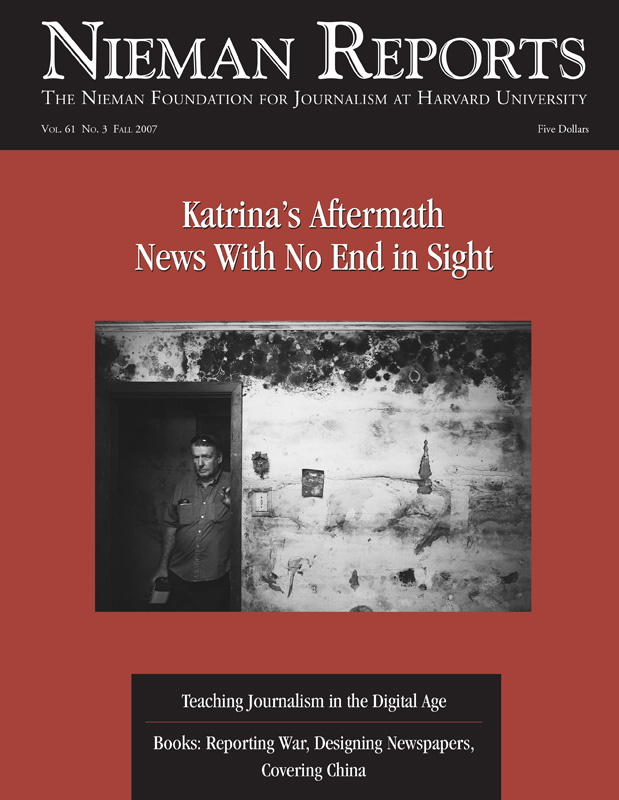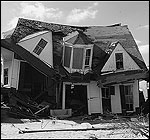Hurricane Katrina changed our landscape, changed our lives and changed — in fact, it arguably improved — the way we practice journalism. Nearly everything we publish has been influenced by the storm. With the storm’s two-year anniversary just behind us, its aftermath remains the biggest — and certainly the lengthiest — story any of us have ever tried to tell.
Despite post-Katrina’s unrelenting dominance in our daily newsgathering, when visitors come to our newsroom they often ask whether we are “back to normal yet.” In many ways, this inquiry about our personal circumstance has morphed into an assumption common outside of our region that we are, in fact, back to normal. When representatives from Lloyd’s of London came on a fact-finding tour of the Gulf Coast a few weeks ago, they were shocked that we weren’t finished with the recovery and rebuilding process. They were absolutely stunned to find still hollowed-out buildings, vacant lots, and so much left to do.
Amid the devastation in which all of us still live are critical stories to tell. But since the hurricane’s first-year anniversary readers have let us know they are “tired” of such stories. What they tell us they want are stories about progress, not what’s still not done, though we receive plenty of calls asking us to do a story when debris or abandoned houses sit too long in their neighborhoods. And reporters also want to work on stories that mark progress and show signs of our recovery. Images of row upon row of FEMA trailers and reporting on dangerous formaldehyde levels, while an important story, is not one we can keep giving our readers day after day. And these days, when we do FEMA trailer stories, we make sure to ask our photographers to look for new ways — different angles or fresh vantage points — to make an all-too-familiar visual image capture the eyes of our readers.
Recently, on a story we did about construction — one with a lot of different angles in a post-storm environment — our approach was to explore why and how building was slowed due to a cumbersome permitting process in our two large cities — Gulfport and Biloxi. Since many of our readers are feeling frustrated by this process, too, our story was well received. And our photographers thought long and hard about how to best tell the visual story before deciding on a building site with no one present and very little work completed.
Heading now into our third year of tracking the various directions in which the Katrina story ebbs and flows, we try to focus on stories in which our reporting will make a difference in the lives of our readers. Often this comes in the form of follow-the-recovery-money stories — such as paying a lot of attention to the grants being received and appropriations from Congress. Or it comes as watchdog stories, such as those investigating fraud or those in which our reporters keep a watchful eye on city council meetings when SmartCode [a new approach to zoning] or Advisory Base Flood Elevations (ABFEs) are discussed and adopted, so that people can rebuild homes and know what will be required to insure them.
Angles and questions our reporters pursue include the following:
- What is being done—or not being done—to help community residents recover and move past the damage done by the storm?
- Is a community embracing SmartCode? If not, what does this mean for businesses and residential areas in terms of rebuilding?
- Will city councils in different communities adopt ABFEs?
- Are water and sewer lines being replaced so that people can rebuild their businesses and homes?
- Is money set aside for these purposes being spent appropriately?
Our newspaper’s watchdog role, in particular, has increased exponentially. Our reporter, Anita Lee, has been dogged in pursuing stories about insurance — arguably the topic of greatest interest for many of our readers. Her stories have carefully chronicled an insurance company’s plan to change their protocol for assessing and paying claims based on wind vs. water. It was Lee’s reporting that let our readers know that despite help from the state legislature, a new policy for wind damage would cost about $5,000 annually for a $250,000 house — a huge increase from what residents had paid before Katrina — and that makes rebuilding a difficult decision for many.
We know, too, that we can’t just write “process” stories or inform readers about government action or inattention. People need to see themselves and their neighbors’ lives in our daily coverage, as well as hear about the thousands of volunteers who’ve come to help them rebuild. These everyday stories — such as the one we recently published about a couple who is raising vegetables and selling them at a roadside stand — are reminders that we haven’t forgotten this is a community. It is ordinariness and optimism; the story said to our readers, “We’re going to be OK.”
Responding to Charges of Biased Reporting
Once the national media left Mississippi several weeks after Katrina roared through, those of us left came to understand — more than we did before — the invaluable role that daily journalism must play in this recovery effort. But the dominant question, even now, is how we report on our community with a staff whose lives are as affected by the storm as those of our readers. This has meant that objectivity is a newsroom issue we’ve tackled head-on since the first few days after Katrina hit. Everyone at the paper — editors and reporters included — have insurance issues and housing problems, transportation challenges and medical needs. One reporter lost a member of her family in the storm. Name a circumstance and someone in our newsroom has experienced it. As a result, editors didn’t even try to tell reporters or photographers to put aside their lives to tell these stories. Instead, we asked for fairness and balance in the reporting they brought us, and we reminded ourselves to look even harder than we normally do for evidence of any bias that a reporter might inadvertently bring to the piece.
Since Katrina, we’ve done this by carefully matching reporters with stories that they have the skills needed to tell. (Those beats and stories requiring a watchdog approach, for example, are given to those whose investigative abilities are strong.) And we constantly converse with them as they report and are diligent in the editing process to make certain — as best we can — that what we publish is a fair representation of what our reporters have been able to learn. Editors also check editors in much the same way — an acknowledgement that we are not immune from the possibility that our personal situation might taint decisions about the stories we assign and approaches we could advise our reporters to take.
Getting this formula to work as well as it can is a daily exercise, one still in progress. In the insurance industry, there are those who don’t find our reporting “objective,” pointing out that our beat reporter has insurance issues since she lost her house in the storm. (The insurance industry might not like our stories, but its representatives have yet to tell us that they aren’t accurate.) This assertion of bias has been raised when local agents talk with customers about their policies, from corporate officers on editorial boards, and in comments made to other journalists. We’ve heard this charge raised in our Sound Off line, an anonymous call-in line that allows readers to bring up subjects or offer news tips. (Others in the business have admitted that our reporter presented fairly their side of the issue.) We publish a sampling of these comments each day.
We believe Lee’s reporting about this incendiary issue of insurance has been abundantly fair. It’s certainly won her the respect of our readers and her newsroom peers and even from some in the insurance industry. Yet these criticisms are what she constantly deals with as part of her beat.
Our executive editor, Stan Tiner, said early on that in the post-Katrina world “every story is a business story” as the Gulf Coast recovers from the storm. That’s turned out to be true, but I’d add another newsroom maxim that “nearly every story is a post-Katrina story.” Even routine coverage of city council and board of supervisors meetings, the business council, and gaming commission has the undercurrent of recovery running through it. Planning and zoning board meetings — once the purview of only a few civic-minded individuals — are now events of great community interest; the Sun Herald devotes a lot more attention to these deliberations than we did before the storm. Our reporters know more about SmartCode as a way to rebuild a community than we ever thought possible. They know how to read detailed insurance policy clauses and calculate bridge spans and flood elevations and, as a result, so do our readers.
Before August 29, 2005, many of our older readers measured their lives by what happened before and after Hurricane Camille, which hit in mid-August of 1969. Katrina is this generation’s Camille, only more so. And so as we adjust our coverage — and the work needed to accomplish it — we need to be sensitive to the trauma that all of us in the newsroom have also experienced in our personal lives. As editors, we have accommodated reporters and photographers as they have had to take time away from their jobs to deal with insurance adjusters, contractors, medical needs, permit offices, and dozens of other unexpected situations.
Just as the rest of the community tries to recover — and sometimes looks to our newspaper for help in doing so — we, too, cope with our recovery while finding fresh ways to respond to the community’s reliance on us.
Kate Magandy is city editor of the Sun Herald in Biloxi/Gulfport, Mississippi.



